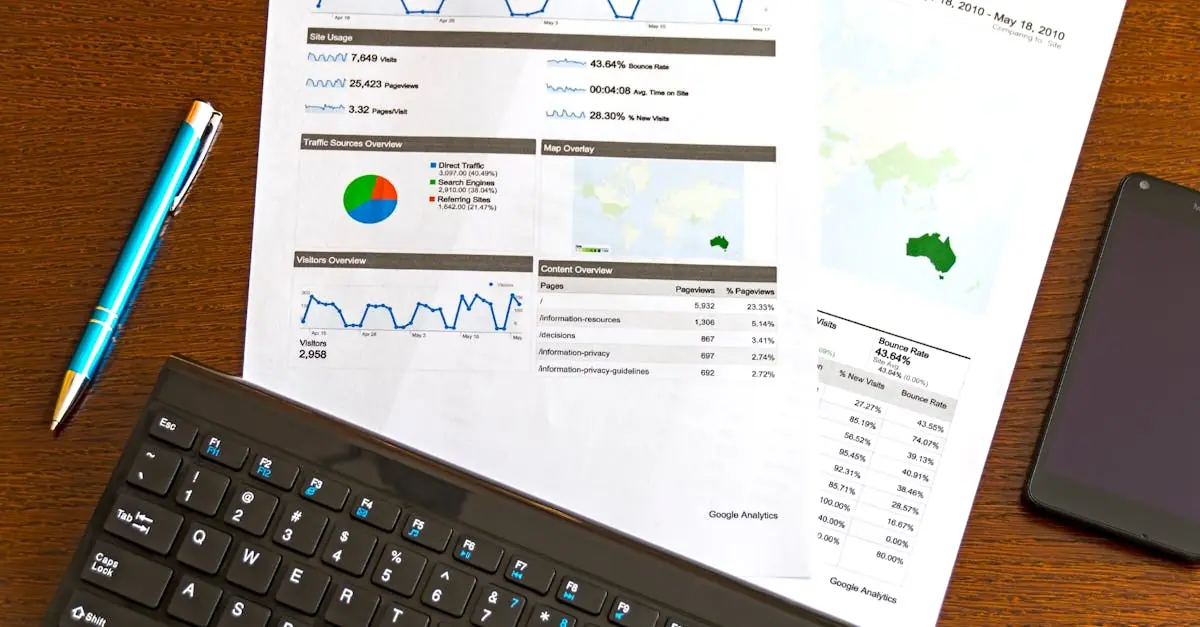Table of Contents
ToggleIn a world where headlines often scream about crises, the untold stories of resilience and hope deserve a spotlight. The refugee intake summary offers a glimpse into the journey of those seeking safety and a fresh start. It’s not just a collection of numbers; it’s a tapestry woven with courage, dreams, and the occasional mishap—like the time someone mistook a suitcase for a karaoke machine.
Understanding the dynamics of refugee intake is crucial for fostering empathy and informed discussions. As nations grapple with how to welcome newcomers, this summary reveals trends, challenges, and successes that shape the lives of countless individuals. Dive into the details and discover how every statistic represents a life transformed—because behind each figure is a tale waiting to be told.
Overview of Refugee Intake Summary
The refugee intake summary serves as a crucial document detailing the number of refugees accepted by nations. This summary includes important statistics such as countries of origin, demographics, and the challenges encountered during resettlement. Specific numbers indicate trends that emerge from refugee stories of resilience and hope.
Diverse nationalities represent the global refugee population. Organizations and governments track these statistics to monitor which regions experience the highest influx of people fleeing conflict. It emphasizes not just numbers but also highlights individual narratives of courage, providing context to the data.
Undoubtedly, various factors impact refugee intake processes. Some nations prioritize specific populations based on urgent humanitarian needs, while others focus on economic or skill-based criteria. Each decision influences the overall dynamics of refugee integration and acceptance.
Success stories emerge within this context, portraying the positive contributions that refugees make to their new communities. These individuals bring unique skills and perspectives, enriching the cultural fabric of their host countries. Personal stories often illustrate how refugees overcome obstacles to achieve their dreams.
Challenges remain prevalent in the resettlement process. Legal hurdles, language barriers, and cultural differences can hinder the successful integration of refugees. Recognizing these struggles is essential for fostering empathy and informed discussions about policies.
Data visualization plays a key role in understanding trends within refugee intake. Infographics and charts help illustrate demographic shifts and changes in acceptance rates over time. Such tools make the information more accessible and encourage broader public engagement with refugee issues.
Current Statistics
Current statistics reveal critical insights into the ongoing refugee crisis. Highlighting these figures showcases the scale and urgency of the situation.
Global Refugee Numbers
As of 2023, the United Nations High Commissioner for Refugees (UNHCR) reports that over 26 million people globally are recognized as refugees. Among these, the majority originate from Syria, Venezuela, and Afghanistan. The continually rising numbers indicate the global challenges of conflict, persecution, and violence. Nearly 50% of refugees are children, underscoring the need for tailored support services. Approximately 4.5 million refugees have sought asylum in industrialized nations, reflecting shifting patterns in migration.
Country-Specific Intake Data
Countries vary significantly regarding refugee intake rates. In 2022, the United States accepted around 100,000 refugees, a substantial increase from previous years. Canada welcomed over 40,000 refugees, implementing programs that prioritize family reunification and humanitarian needs. Germany remains a key player, admitting approximately 35,000 refugees, focusing on skilled migration from regions of conflict. France reported an intake of about 30,000 refugees, emphasizing support for unaccompanied minors. Collectively, these figures provide a clearer picture of how different nations approach refugee resettlement and integration efforts.
Procedures and Policies
Refugee intake procedures and policies play a vital role in ensuring a systematic approach to resettlement. These processes vary across countries, reflecting diverse strategies to accommodate refugees.
Application Process
The application process for refugees typically involves multiple steps, beginning with initial screenings and background checks. Countries usually require refugees to submit a formal application along with supporting documentation, such as proof of persecution. Interviews with immigration officials follow to assess claims and verify identities. Approved applicants often undergo further health screenings before traveling to their new location. This thorough approach aims to uphold security while facilitating a smooth transition for refugees.
Eligibility Criteria
Eligibility criteria for refugee status focus on specific humanitarian grounds and legal definitions. Each country defines eligibility based on international guidelines, often prioritizing vulnerable groups such as women, children, and those facing violence. Countries may also consider political persecution and human rights violations when determining eligibility. For instance, UNHCR mandates recognition of individuals fleeing serious threats to life and freedom. Understanding these criteria is crucial for potential applicants and advocates seeking to navigate the refugee system effectively.
Impact on Host Countries
Host countries experience both challenges and benefits from increased refugee intake. The presence of refugees often generates significant economic effects.
Economic Effects
Refugees contribute to labor markets, filling critical gaps in sectors such as agriculture, healthcare, and construction. Some studies indicate that refugees can boost local economies by increasing demand for goods and services. For instance, in the United States, accepting around 100,000 refugees in 2022 has led to job creation and entrepreneurship opportunities. Canada, with over 40,000 new arrivals, benefits from the diverse skill sets refugees bring, strengthening various industries. Host countries often experience a rise in workforce participation rates, particularly as many refugees are eager to work and integrate into their new environments. While initial costs for services may arise, the long-term economic contributions frequently outweigh these expenses.
Social Integration
Social integration poses both opportunities and challenges for refugees and host communities. Many refugees seek connection and belonging and actively participate in local events, fostering cultural exchange. Programs supporting language acquisition and job training significantly aid integration efforts. Collaboration among community organizations often plays a key role in facilitating these programs. For example, in Germany, the admission of approximately 35,000 refugees has led to initiatives that promote social cohesion. Language barriers may arise, impacting communication, but outreach efforts and community support networks help bridge these gaps. Understanding local customs and building relationships ultimately enhances the social fabric, creating a more inclusive environment for all residents.
Challenges and Issues
Numerous challenges hinder the refugee intake process, impacting both refugees and host nations. Public perception plays a crucial role in shaping policies and attitudes toward refugees.
Public Perception
Negative perceptions about refugees often stem from misconceptions or media portrayals. Skepticism surrounds the economic impact refugees may have, with some believing they burden social services. Shifting narratives toward emphasizing contributions can foster greater acceptance. Highlighting stories of resilience may increase empathy among local populations. Community engagements that educate about refugee experiences help build understanding. Ultimately, successful integration depends significantly on combating stigma and tailoring outreach efforts.
Logistical Barriers
Navigating logistical barriers complicates refugee resettlement efforts. Resource shortages in host countries limit the capacity to support incoming populations. Long processing times for applications create uncertainty for refugees anticipating arrival. Complicated legal frameworks often slow down the intake process. Coordination among various agencies can lead to inefficiencies and delays. Collaboration between governments and NGOs is essential to address these issues effectively. Meeting the unique needs of refugees requires flexible policies and well-structured plans.
The refugee intake summary highlights the profound impact of individual stories woven into the broader narrative of resilience. It underscores the importance of understanding not just the statistics but the human experiences behind them. As nations navigate the complexities of refugee resettlement, fostering empathy and informed discussions remains essential.
Recognizing the contributions refugees make to their new communities can shift public perception and promote inclusivity. Addressing the challenges they face through collaborative efforts among governments and NGOs will pave the way for more effective policies. Ultimately, embracing the shared humanity in these stories can lead to a more compassionate approach to refugee intake and integration.







